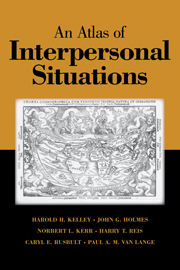Book contents
- Frontmatter
- Contents
- Preface
- PART ONE INTRODUCTION AND THEORY
- 1 Interpersonal Situations: The Context of Social Behavior
- 2 Outcome Interdependence
- 3 Interaction Conditions and Person Factors
- 4 Exploring the Geography of the Outcome Patterns
- PART TWO THE SITUATIONS
- Single-Component Patterns
- Two- and Three-Component Patterns
- Time-Extended Patterns
- Incomplete Information Situations
- N-Person Situations
- Movement from One Situation to Another
- PART THREE EPILOGUE
- References
- Author Index
- Subject Index
2 - Outcome Interdependence
Published online by Cambridge University Press: 21 October 2009
- Frontmatter
- Contents
- Preface
- PART ONE INTRODUCTION AND THEORY
- 1 Interpersonal Situations: The Context of Social Behavior
- 2 Outcome Interdependence
- 3 Interaction Conditions and Person Factors
- 4 Exploring the Geography of the Outcome Patterns
- PART TWO THE SITUATIONS
- Single-Component Patterns
- Two- and Three-Component Patterns
- Time-Extended Patterns
- Incomplete Information Situations
- N-Person Situations
- Movement from One Situation to Another
- PART THREE EPILOGUE
- References
- Author Index
- Subject Index
Summary
A “situation” is defined in the dictionary as “a position with respect to conditions and circumstances,” or, more generally, as a “site” or “problem.” These introductory chapters describe how, in keeping with that definition, we describe and distinguish among situations involving several persons, that is, interpersonal situations. In this chapter, we give concrete examples of a simple yet useful method for characterizing such situations, namely, the “outcome matrix,” and explain the rationale for its use. We then show the implications of that method as well as some of its limitations. Chapter 3 describes our remedies for those limitations.
This Atlas is based on a particular theory known as “interdependence theory.” It was first presented by Thibaut and Kelley (1959) and then elaborated in Kelley and Thibaut (1978) and Kelley (1984b). It derives from Kurt Lewin's emphasis on interdependence as “the essence of a group” (1948, p. 84), and it implements that view by borrowing payoff matrices from game theory (Luce & Raiffa, 1957) and adapting them to the broader purposes of an interpersonal psychology. Other, newer elaborations of the theory, concerning situational conditions affecting the timing and sequencing of behavior and the availability of information, are less well developed but deserve and receive attention in our Atlas.
The theory aspires to provide a means for drawing systematic and logical distinctions among situations which make it possible to imagine laying them out on a “map” or “globe” of the situational “world” – hence our metaphor of an “atlas.”
- Type
- Chapter
- Information
- An Atlas of Interpersonal Situations , pp. 17 - 50Publisher: Cambridge University PressPrint publication year: 2003



